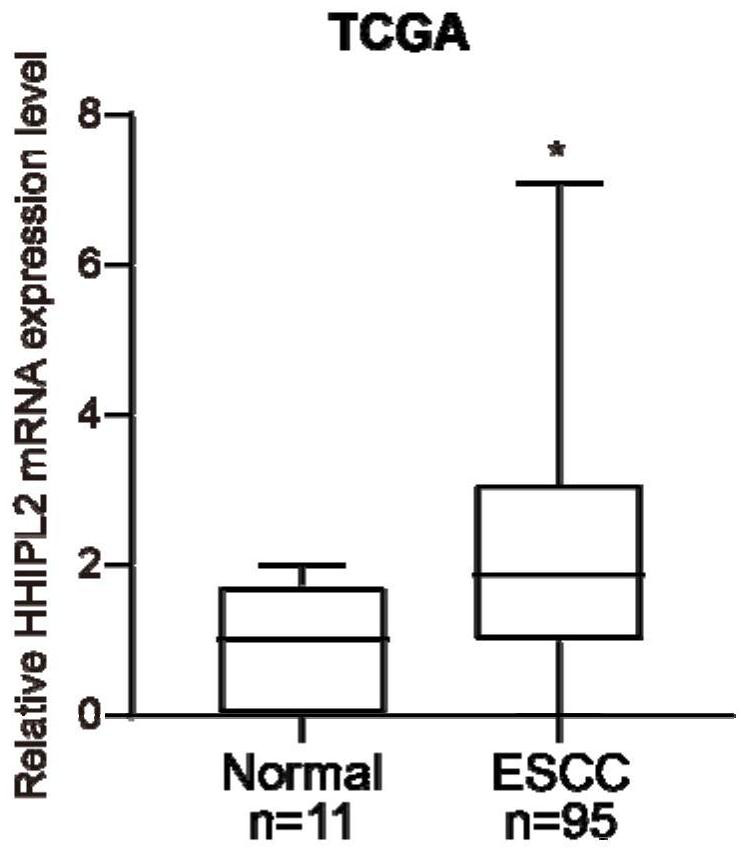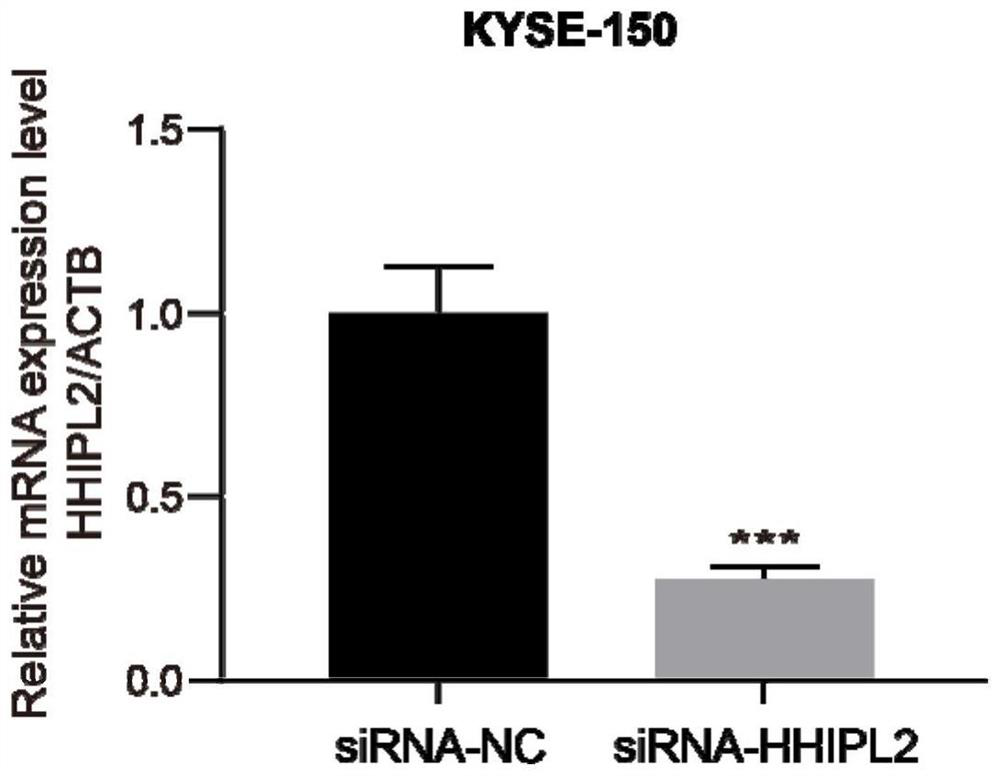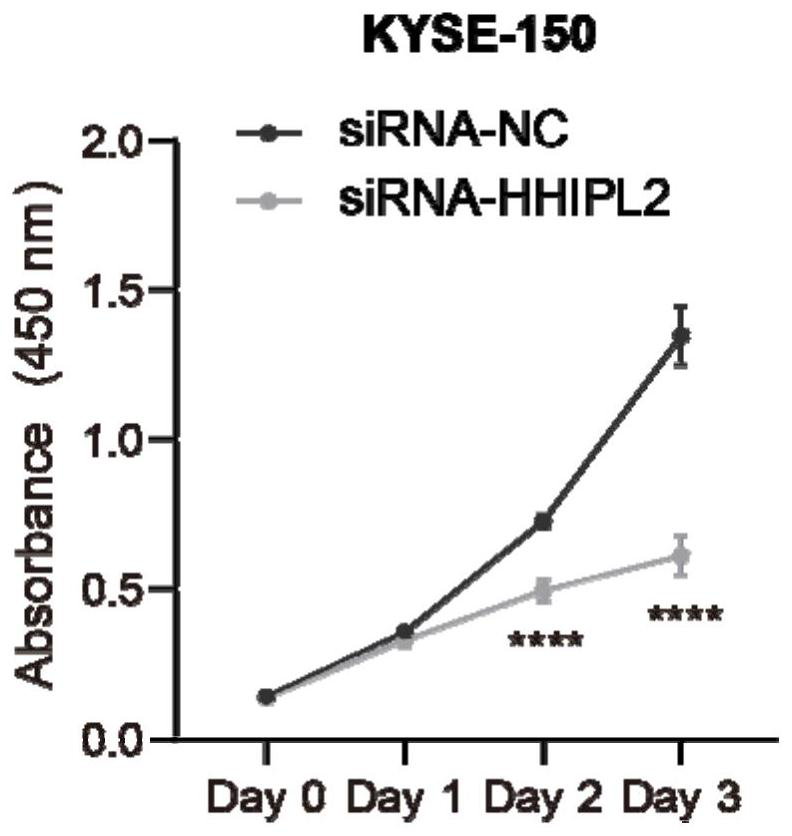Application of human HHIPL2 mRNA in targeted therapy and prognosis evaluation of esophageal squamous cell carcinoma and kit
A prognostic evaluation and targeted therapy technology, applied in the field of biomedicine, can solve problems such as restricting esophageal cancer
- Summary
- Abstract
- Description
- Claims
- Application Information
AI Technical Summary
Problems solved by technology
Method used
Image
Examples
Embodiment 1
[0034] The TCGA database was used to analyze the sequencing data of esophageal squamous cell carcinoma (ESCC). figure 1 shown.
[0035] The specific implementation process is as follows:
[0036] Download the ESCC specimen sequencing data in the TCGA database and calculate the log of each sample 2 Count value, including 11 cases of adjacent normal esophagus tissue and 95 cases of ESCC tumor tissue samples, with the log of adjacent normal esophagus tissue 2 The average Count value was used as the reference, and the relative expression levels of HHIPL2 mRNA in 95 ESCC tumor tissues were calculated.
Embodiment 2
[0038] siRNA-HHIPL2 was designed, siRNA-HHIPL2 and siRNA-NC were transfected into KYSE-150 cells, respectively, and the knockdown level of HHIPL2 mRNA in KYSE-150 cells was detected by reverse transcription-real-time fluorescence quantitative PCR. The siRNA-HHIPL2 The target sequence is shown in SEQ ID NO.2, the substance used to detect the expression level of HHIPL2 mRNA is the primer pair provided by the present invention, the upstream primer sequence is shown in SEQ ID NO.3, and the downstream primer sequence is SEQ ID NO.4 shown, the specific results are as follows figure 2 shown.
[0039] Depend on figure 2 It can be seen that siRNA-HHIPL2 can effectively and specifically knock down the expression level of HHIPL2 mRNA in KYSE-150 cells.
[0040] The specific implementation process is as follows:
[0041] (1) Design an siRNA (siRNA-HHIPL2) that can target the HHIPL2 mRNA coding region sequence, and its targeting sequence is 5'-cacaatcgcaagttctata-3' (SEQ ID NO.2);
...
Embodiment 3
[0052] KYSE-150 cells were cultured in 6-well plates, and siRNA-HHIPL2 (SEQ ID NO. 2) that specifically interferes with HHIPL2 mRNA expression was transfected into KYSE-150 cells, and the knockdown expression of HHIPL2 mRNA was detected by CCK-8 assay The effect on the proliferation ability of KYSE-150 cells, the specific results are as follows image 3 shown.
[0053] Depend on image 3 It can be seen that the specific knockdown of HHIPL2 mRNA expression level by siRNA-HHIPL2 can significantly inhibit the proliferation of esophageal squamous cell carcinoma cells.
[0054] The specific implementation process is as follows:
[0055] (1) siRNA-HHIPL2 and siRNA-NC were respectively transfected into KYSE-150 cells. The specific method was shown in Example 2. 24-36 hours after transfection, the cells were collected, and the cell concentration was adjusted to 25,000 cells / mL medium. Add 100 μL of cell suspension to each well of the 96-well plate, set 6 duplicate wells for each ce...
PUM
 Login to View More
Login to View More Abstract
Description
Claims
Application Information
 Login to View More
Login to View More - R&D
- Intellectual Property
- Life Sciences
- Materials
- Tech Scout
- Unparalleled Data Quality
- Higher Quality Content
- 60% Fewer Hallucinations
Browse by: Latest US Patents, China's latest patents, Technical Efficacy Thesaurus, Application Domain, Technology Topic, Popular Technical Reports.
© 2025 PatSnap. All rights reserved.Legal|Privacy policy|Modern Slavery Act Transparency Statement|Sitemap|About US| Contact US: help@patsnap.com



